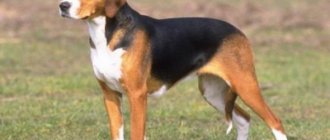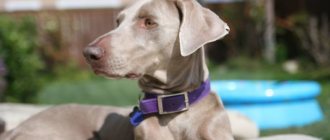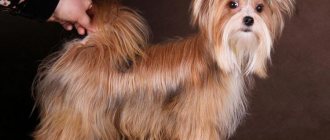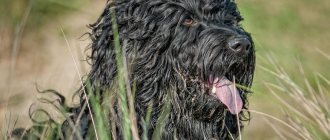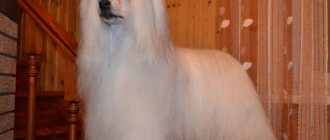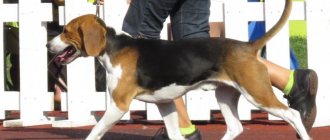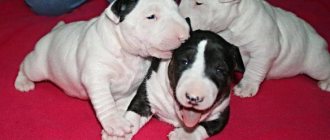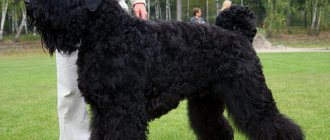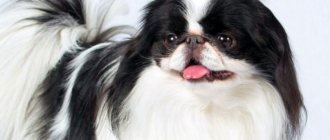Home » Dog Breeds
Classification Origin: Russia
Class: FCI not recognized
Color: allows light black or black, grayish, crimson. The spots can be of any size and shape, the markings are not bright. The chest, paws and shoulders are characterized by white color.
Dimensions: at the withers from 56 to 68 cm, weight on average 30 kg.
Life expectancy: about 12 years, maximum up to 15-16.
The Russian hound (or, according to another version of the name, the Russian piebald hound) looks stately. The dog is quite large in size, with a pronounced hunting instinct and a balanced, peaceful character.
Suitable for home keeping outside the city and for those people who are not going to take it hunting.
Russian piebald hound is an excellent hunting breed
- 2 Psychology
- 3 Application
- 4 How to choose a puppy
- 5 Features of care
- 6 Combing
- 7 Walking
- 8 Food
- 9 Health
- 10 Characteristic diseases
- 11 Vaccinations
- 12 Mating
History of the breed
In Kievan Rus, it has long been customary to go hunting with these large dogs, which work well both in a pack and alone.
Today, the breed is divided into two subspecies: the Russian piebald hound, which is often called the Anglo-Russian hound, and also simply the Russian hound. In fact, there are no particular differences between dogs.
Previously, they were not identified as a breed at all. Although since the times of Kievan Rus, these strong, well-built animals were constantly taken for driving game.
The first breed standard appeared only in 1895. However, at that time in Russia there were few producers with high qualities and characteristics, most puppies were born frankly weak, unsuitable for serious exhibitions, and the development of the breed was not observed.
The standard was revised once again and finally approved in 1951, but the FCI has not yet recognized the breed.
Often, the Russian hound is confused with the Estonian , and no wonder - their color and general features are similar. Both dogs belong to the hound .
Russian piebald hound on the hunt: working in a pack
Today we can say that the Russian piebald hound is extremely popular among domestic hunting enthusiasts, but in Europe it is practically not bred.
Interesting! In Rus', these dogs were known back in the 10th-11th centuries, they were widely used and called “yappers”. The pets received this nickname due to the characteristic, slightly nervous bark that they begin to emit when attacking an animal trail.
General characteristics of the breed
This dog is balanced and intelligent . It is distinguished by a strong physique and a typical hound exterior. Its weight is not specified by the standard, but it usually reaches an average of 25-30 kilograms. Height at withers – no more than 66 cm.
Often there are white dogs with spots of red or black on the head, shoulders and back of the body. But the paws and belly are always white. The Russian hound is easily distinguishable from the beast, precisely due to its characteristic color, which allows the hunter not to shoot it by mistake.
Psychology
Let's start with the fact that the Russian piebald hound is a hunting dog, hence all the specifics of its character, instincts, and behavior. When hunting in Russia, in addition to the Russian hound, the Russian greyhound , which was also called the hound.
Breeders and dog handlers define the breed as psychologically stable, balanced, with a clear display of friendliness towards humans.
This is a true friend, devoted and faithful. Dogs sincerely become attached to their owner, and in his hunting activities they become invaluable helpers. Chasing an animal, corralling it – these skills are at the highest level in a hound.
Russian piebald hound before hunting
Children are also treated kindly; sudden attacks of aggression are not typical for them and are not observed. The downside is an irresistible urge to hunt, because the dog was created to chase game.
About other dog breeds that are suitable for children:
During a walk, he can easily break loose and run after a cat or other small animals.
Important! The dog should not be let off the leash, even if it is well trained. The animal can easily run away, so it is also not recommended for children to accompany it; it would be better if the leash is held by an adult.
Russian hounds have very high intelligence. But dogs have a strong desire to be in charge, to dominate in the pack. That is why the owner should not forgive the puppies disobedience, otherwise it is very easy to lose authority, and it is almost impossible to restore it.
Hounds are easy to train. From the very first days, the cubs are accustomed to the sound of the hunter's horn, and one of the first skills acquired is unquestioning obedience to the command to leave the prey. Otherwise, the dog will tear the animal apart during the hunt.
Breed card
- Known names of the breed : Russian hound, Gontchaja russkaja, Russian harlequin hound
- FCI breed number: not recognized
- Description of the standard on the FCI website: link
- Height at the withers: males - up to 68 cm, females - up to 65 cm
- Adult dog weight: approximately 30 kg
- Color options: black-and-white, underhair, crimson
- Life expectancy: up to 16 years
- Puppy cost: from 7,000 to 15,000 rubles
- Size: 4 out of 5
- Learning ability: 3 out of 5
- Attitude towards children: 3 out of 5
- Shedding intensity: 3 out of 5
- Protective and guard qualities: 3 out of 5
Application
The Russian Hound looks balanced and dignified, but in reality this is a deceptive impression. A dog vitally needs space, just like herding dogs like the Kangal and Groenendael , and hunting instincts cannot be eradicated by any education, because they are the essence of the breed’s character.
Let's look at the possibilities of application in several guises.
- Hunting assistant. Here the dog is truly irreplaceable, and she will like such a life. It is recommended to keep the animal in an enclosure, where it can stretch, run, and burn off energy.
- Watchman In principle, like any other dog, this one can also be put on a chain. But such use will result in stress for the pet. For hundreds of years, the Russian hound has been used as a friend and assistant to humans. She was used to trusting and working with him. It is highly not recommended to put him on a chain: it will be a bad watchman, and his character will also deteriorate due to improper maintenance.
- A pet. Theoretically, a dog can be kept in an ordinary city apartment. But it will be torment for both her and the owner. The animal is very active, has a pronounced desire to chase, and needs to run. Therefore, aviary keeping is highly recommended.
Important! When getting a hunting dog, do not forget about its developed instincts, which cannot be avoided. He will chase cats, chase birds and scour in search of game, too. That is why dog experts recommend using the breed for its intended purpose, where it will show its best side.
The Russian hound puppy is still just a baby
Content
Dogs also need regular grooming. Feed your hound and take care of its coat properly.
Ideal diet
- Up to a month or two, Russian hound puppies feed on their mother's milk. Then they are accustomed to porridges and liquid soups. From the age of one month, you can periodically feed raw meat. The diet should include vitamins and minerals. It is recommended to place the bowl on a stand so as not to spoil your posture.
- After two months. During this period, it is already possible to give cartilage and raw bones, which, moreover, promote teething. A growing body requires meat. Cooked chicken and/or raw beef will do. The daily meat dose should be divided into 3-4 servings. Puppies also need: milk, cheese, cottage cheese, fruits, vegetables, eggs.
Those who prefer feeding dry food need to ensure that their dogs drink plenty of water. It is better to soak the food in liquid first.
- Feeding adult hounds. The main part of the diet should be raw meat and boiled or stewed fish. Another essential source of protein is dairy products. As for carbohydrates, these are cereals, and bakery products are recommended to be excluded from the diet.
Grooming
The coat of dogs of this breed does not require special care. Russian hound puppies should already be accustomed to brushing. It is very important to get rid of dead hair before water treatments. The latter should be practiced as needed. To avoid damaging the coat, do not apply shampoo directly to it. The detergent is diluted in a container, the dog is rinsed with foam, and then washed with a shower a couple of times.
How to choose a puppy
Russian hound puppies look unusually cute in the photo, but they are not easy to keep. If you choose your pet correctly, then it will perform well both in hunting and in training.
Otherwise, you will get a stubborn animal prone to dominance. It is for this reason that only experienced dog breeders are recommended to own a pet.
- Those puppies that show obvious physical defects by the age of one month are immediately discarded. Most often, a bulldog jaw or, conversely, a noticeable lengthening of the upper jaw in comparison with the lower. An incorrect taste is a sure sign that degeneration is occurring.
- The second point is the eyes. Their color is extremely important when choosing a puppy. The ideal baby is the one whose eyes are the darkest, hazel. If green predominates, it is a fault according to the standard. And it is absolutely impossible for the color of the eyes to differ.
- The third point is the nose. It shouldn't be pink. This is a defect called marbling of the flair and manifests itself as the coloring of the entire lobe pink, or only the central area (looks like a spot).
Important! Choose a puppy after he is a month old. All of the listed vices can appear in the first days, and then go away. But if they are preserved after a month of age, then they will remain so.
High-quality purebred Russian hound puppies
Finally, it's time to pay attention to the character of the future pet. Experts advise taking the most active, physically strong puppy, and size usually doesn’t matter much.
But what is really important is the proportionality of the build: high-quality Russian piebald hounds look good and harmonious even at a young age.
Be sure to find out everything about the pedigree and behavioral characteristics of the ancestors of your future pet. Sometimes there may be livestock hunters in the family - individuals who attacked livestock, usually sheep.
It is no less bad if there were cases of the birth of silent dogs - dogs that do not give a voice when driving prey. Experts do not recommend adopting puppies with such pedigrees. For a dog, characteristic hunting instincts are extremely important, without any failures.
That is why, before choosing a puppy, it is imperative to thoroughly study all of its ancestors.
Advice! Get to know the babies in their first days of birth. At this time, you can easily determine how good their instincts are. Blind puppies sense mother's milk through it. Those who react more actively to the appearance of a catch, squeal, reach for it, and have a better sense of smell.
Nursing dog with puppies and a puppy
Care and maintenance
This dog is not suitable for closed apartments . She will like it much more in an enclosure on her garden plot. This kind of content is just for these dogs. This hunter needs both walks and physical activity. At the same time, your pet should have free access to the house; it is not recommended for him to live on the street. But there is no particular reason to patronize. He will not need warm clothes in winter, but protective overalls on a rainy day are advisable. And for walks in the forest it’s a good idea to have waterproof clothing.
But you should only walk your pet on a leash, so that the hunting instinct does not force him to attack a small animal he encounters or simply run away.
His coat is quite easy to care for. It is enough to comb out occasionally with a brush. And they bathe the dog only when necessary, more often after a hunt.
This dog will have to be walked a lot. If you are not able to devote four hours to walks and joint training, pay attention to another breed. The Russian Hound is not for you. In summer, it is better to examine your pet's eyes every day. Teeth and ears will only require preventative cleaning.
Features of care
Caring for and raising a dog is not so easy. It is important to follow several rules that will help you establish contact with your pet and raise a smart, useful, and loyal animal.
- The dog must immediately respond to the owner’s call;
- The pet knows for sure that the owner is in charge, but he will never hurt or yell;
- The dog’s hierarchy is strictly observed; manifestations of dominance over a person are not allowed;
- Execution of basic commands is flawless.
If you initially base your communication with your dog on these rules, there will be no problems in the future.
Animals are sensitive to care and care. They love affection and are devoted to their owner and his family members.
Advice! Do not keep your Russian Hound with other animals! This dog doesn't get along with them, especially cats.
A pack of Russian hounds with prey
Walk
Children should not be trusted to perform this procedure, which is pleasant for such an active pet. The dog can break into a run at any moment, so the child simply cannot cope.
Moreover, the animals are very strong and strong. By nature, Russian hounds are friendly to their own, but extremely hostile to all strangers, which makes walking much more difficult. It is recommended to use a dog harness when walking.
This article will tell you how to choose a leash for your dog.
The best option for walking your dog is in the forest or field
But you can release the dog outside the city and let it run around to its heart's content, so you should not have a pet in the city. But if you do take a risk, never let him off the leash.
Nutrition
For a dog, the process of digesting food takes approximately 8 hours, and if it is given food only once a day, the animal will be hungry most of the time.
That is why the prescribed amount of food should be divided into 2-4 doses. Focus on your pet's preferences: some people like to eat a heartier meal after a night's sleep, while others, on the contrary, prefer to have a hearty dinner. The volume of each portion depends on this.
Now about the diet. Since the breed is a hunting breed, fresh meat comes first and, as a special delicacy, a juicy beef bone.
Eliminate small and hollow bones, such as chicken bones, from the dog’s menu completely. Milk porridge and vegetables are also important. Sometimes include dry food , but without fanaticism.
Prohibited:
- sweets and smoked foods,
- fatty pork meat,
- spices,
- salt,
- vinegar.
If your dog eats very quickly, this article will help you wean him off it.
Health
Dogs have good health, this is due to the specifics of the breed. After all, Russian hunting often took place in the cold season, so faithful human companions required good hardening and excellent immunity.
If you keep your animal properly and feed it rationally, no diseases will arise.
Russian hound in the winter forest
Characteristic diseases
Despite the excellent health, the breed still has a certain tendency to certain problems.
Among the diseases characteristic of Russian hounds are:
- Conjunctivitis is an inflammatory eye disease that often becomes chronic. Especially if you don't take your dog to a vet appointment on time.
- Myositis is muscle inflammation of a different nature (eosinophilic, purulent, rheumatic). Swelling occurs in the tissues, which is accompanied by progressive lameness.
- Degenerative myelopathy is dangerous for older individuals and is expressed in disease of the spinal cord. The dog begins to lose coordination, the back of the body falls to the sides, the animal falls on its hind legs. There is no pain.
- Malignant hypertemia is a common negative reaction in dogs to general anesthesia.
- Hip dysplasia is usually a congenital joint problem that can only be diagnosed in a one- to one-and-a-half-year-old puppy.
Description of the breed
RKF standard dated 04/08/2015 “Russian hound”. Group 6 "Hounds, bloodhounds and related breeds." Section 1.1 “Large hounds”.
The main indicators when assessing sizes are height and elongation index:
- for males (prey) – 58–68 cm; 105.
- for women (vyzhlovka) – 55–65; 107.
The head has the following characteristics:
- The lines of the head silhouette are clear and light. Characterized by a wedge-shaped shape. The muzzle is elongated; in profile, the skull and wings of the nose form a parallel.
- The nose is large, black, protruding forward.
- Lips are dry and dark in color.
- The teeth are powerful, large, white, tightly adjacent to each other.
- The breed is characterized by a scissor bite with a complete dental formula.
- The eyes are medium, brown in color. Eyelids with dark edges and an oblique cut.
- The ears fit snugly to the head and droop. Characterized by a triangular shape and thinness.
Body. The skeleton and muscle corset are well developed, the body has a rectangular format. The neck is low set, has an angle of 30–35 degrees, is dry and covered with long hair.
Well-developed massive withers are also characteristic of Russian hounds, especially males. The chest is lowered below the elbows, the back is straight, turning into a powerful sloping croup.
The tail (rut) is saber-shaped, shortened towards the end, but thick at its base. As a rule, it does not reach the hock joint. When excited it rises above the level of the back, while in a calm state it is lowered.
Limbs. The Russian Hound has strong, muscular legs, set wide and harmonious. The front legs are straight, the height is half the height of the dog. The shoulders are developed, the shoulder blades are tilted towards the body. The forearms are oval shaped and strong.
Characteristic are steep pasterns, almost vertical to the ground. Elbows point back. The paws are oval, with claws pointing to the ground, the toes are tightly closed.
The hind limbs are strong, drawn behind the croup. All joints have pronounced angles. The thigh has an elongated format, the metatarsals are vertical.
Coat color and type. The Russian Hound is a short-haired dog. The dog's fur is slightly longer and is present only around the neck and on the back of the thighs. The breed is characterized by a thick, soft undercoat.
Typical colors of a Russian hunting dog:
- black-and-white;
- light shabby;
- crimson (shades from reddish-yellowish to reddish-light);
- underhaired (grayish with whitish tan marks).
The area and number of black spots is not limited; mild specks and dark arrows on the temples are acceptable.
Any deviation from the standards affects the dog’s health and prevents it from fully performing its work.
The photo of the Russian hound clearly shows all the above listed signs.
Acceptable flaws:
- Height is no more than 2 cm above the standard.
- Slightly short legs.
- Timidity.
- Minor deviations from head standards.
- Insufficiently deep, narrow sternum.
- Mincing, insufficiently free movements.
- Weak undercoat and wavy coat.
Possible defects:
- Growth is below normal limits.
- Significant deviations from head standards.
- Not a black nose.
- The eyes are yellow.
- Missing some teeth.
- Curved or curled tail.
- Complete absence of undercoat and shaggy coat.
Disqualifying faults:
- Not a scissor bite.
- Eyes of different colors, greenish or blue shades.
- Coffee and mouse colors.
- Absence of incisors or molars.
Dogs that are cowardly, aggressive or have obvious physical defects will also be disqualified.
Vaccinations
All vaccination activities are carried out in the same way as for any other purebred dogs, with the exception of animals that for some reason require an individual schedule.
On average, a dog receives its first vaccination after a month of life. Veterinarians recommend that such puppies be vaccinated against distemper and repeat the procedure at least 2 weeks later.
The third time - after replacing all the teeth with molars, approximately 6.5 months (the rabies vaccine is also administered). The vaccination is then repeated annually throughout the dog's life.
